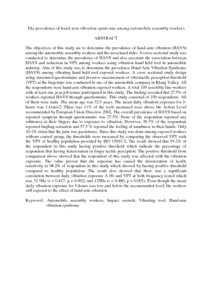Citation
Mohd Tamrin, Shamsul Bahri and Yusoff, Nor Maizura and Abd Rahman, Anita and MSN, Dayana Hazwani and A. Balkhyour, Mansour
(2016)
The prevalence of hand arm vibration syndrome among automobile assembly workers.
Malaysian Journal of Public Health Medicine, 16 (suppl.2).
pp. 128-136.
ISSN 1675-0306
Abstract
The objectives of this study are to determine the prevalence of hand-arm vibration (HAVS) among the automobile assembly workers and the associated risks. A cross sectional study was conducted to determine the prevalence of HAVS and also ascertain the association between HAVS and reduction in VPT among workers using vibration hand held tool in automobile industry. Aim of this study was to determine the prevalence Hand Arm Vibration Syndrome (HAVS) among vibrating hand held tool exposed workers. A cross sectional study design using structured questionnaire and invasive measurement of vibrotactile perception threshold (VPT) at the fingertips was conducted in one of the automobile company in Klang Valley. All the respondents were hand arm vibration exposed workers. A total 109 assembly line workers with at least one year job tenure participated in this study. The finding revealed that 27.5% of workers reported HAVS through questionnaire. This study consisted of 109 respondents. All of them were male. The mean age was 32.9 years. The mean daily vibration exposure for 8-hours was 1.41m/s2. There was 11% of the tools measured were above the Action Level recommended by European Union Directive 2002. The overall prevalence of HAVS based on reported symptom through questionnaire was 27.5%. None of the respondent reported any whiteness at their fingers due to exposure to vibration. However, 36.7% of the respondent reported tingling sensation and 57.8 % reported the feeling of numbness in their hands. Only 10.1% claim that the pain was persistence. Since this study was done among exposed workers without control group, the thresholds were measured by comparing the observed VPT with the VPT of healthy population provided by ISO 13091-2. The result showed that 98.2% of the respondent in this study having positive threshold which indicate the percentage of respondent that having deterioration in finger tactile perception. The positive threshold from comparison above showed that the respondent of this study was affected with the vibration exposure. The value proven that the exposure has caused the deterioration of tactile sensitivity in 98.2% of respondent in this study which showed by having positive threshold compared to healthy population. The result also showed that there was a significant correlation between daily vibration exposure A (8) and VPT at both frequency tested which was 31.5Hz (r = 0.417, p = 0.002) and 125Hz (r = 0.480, p = 0.001). Even though the mean daily vibration exposure for 8-hours was low and below the recommended level, the workers still exposed to the effect of hand arm vibration.
Download File
![[img]](http://psasir.upm.edu.my/53069/1.hassmallThumbnailVersion/The%20prevalence%20of%20hand%20arm%20vibration%20syndrome%20among%20automobile%20assembly%20workers.pdf)  Preview |
|
PDF (Abstract)
The prevalence of hand arm vibration syndrome among automobile assembly workers.pdf
Download (7kB)
| Preview
|
|
Additional Metadata
Actions (login required)
 |
View Item |

